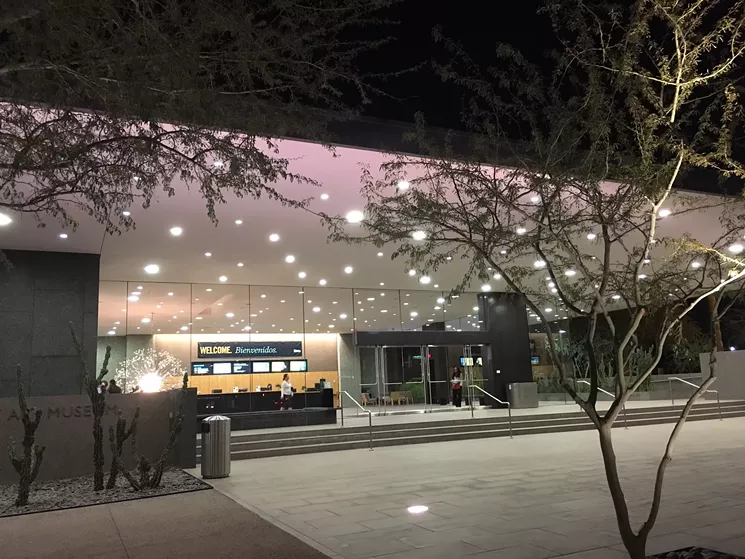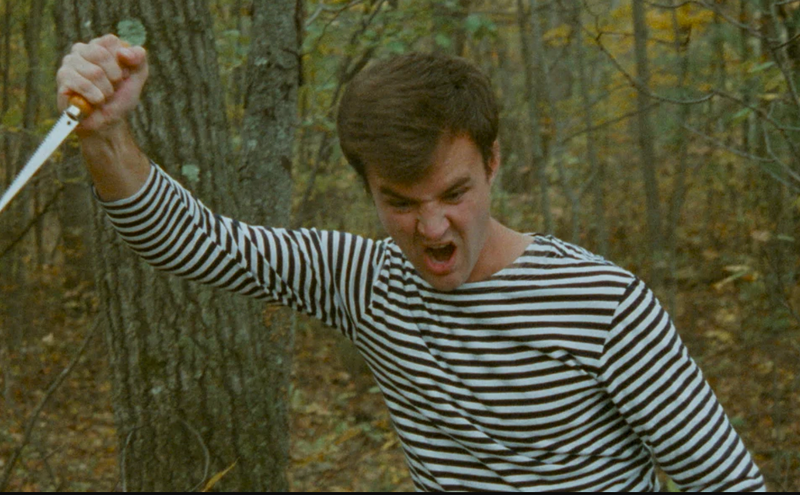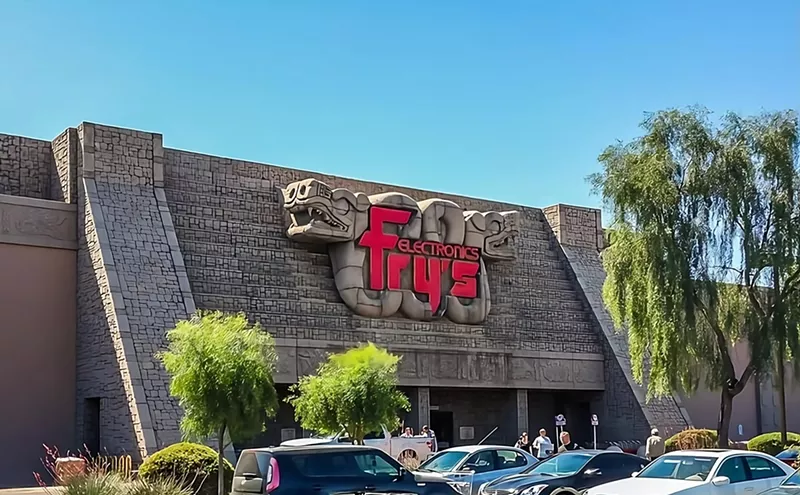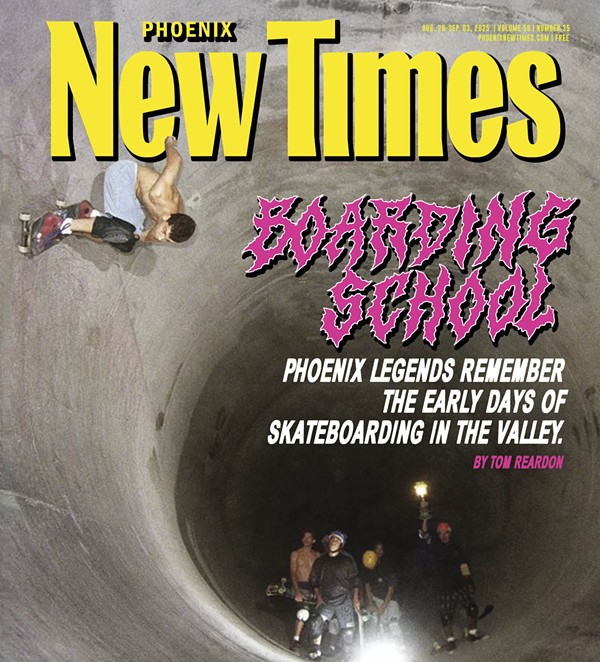Halle is survived by his wife, Diane, four children, seven grandchildren, and three siblings. He left behind more than 900 Discount Tire stores in 31 states, with more than 17,000 employees.
Though Halle was best known as the founder of Discount Tire Company, many Phoenicians also knew him as one of the Valley's most prominent arts patrons. A 2013 exhibition at Phoenix Art Museum showcased more than 50 works from the Halle collection, and the Halle Foundation has paid for free admission to the museum one Sunday or weekend a month since January of that year.
“We are grateful for the honor of having known Mr. Halle, and inspired by all that Mr. and Mrs. Halle’s generosity has made possible for our museum and our community,” said Amada Cruz, director and CEO of Phoenix Art Museum, in a statement sent to Phoenix New Times the day Halle died. “Mr. Halle was a model of profound generosity."
The Halles began collecting Latin American art in 1995, aided by experts including Roland Augustine, who co-founded New York's Luhring Augustine gallery. That gallery's impressive artist roster includes Simone Leigh, a 2018 nominee for the prestigious Hugo Boss Prize, which honors the best international contemporary artists.
"They put together one of the greatest collections of Latin American art in the country," Augustine says of the Diane and Bruce Halle Collection. It includes about 400 to 500 works, he says, by artists that include Ana Mendieta and Hélio Oiticica. And its works have been shown at several esteemed museums, including Museum of Fine Art, Houston and the Art Institute of Chicago.
But the collection, which is replete with work that tackles social justice themes like racism and sexism, stands in stark contrast to Halle’s conservative political views.
Halle founded Discount Tire Company in Michigan 1960, and moved its headquarters to Arizona in 1987. After retiring as CEO, he served as chairman of the board until his death.
In a statement issued on Friday, January 5, Discount Tire CEO Michael Zuieback highlighted Halle’s military service, spirituality, and dedication to both his family and his employees.
“I have had the privilege of working with and learning from the most talented, respected, humble, and kind leader anyone could hope for,” Zuieback wrote, in part.

Entrance to Phoenix Art Museum, one of several arts organizations supported by the Halle Foundation.
Lynn Trimble
Through the years, the foundation made significant donations in several areas, including education, human services, religion, medicine, and the arts.
In 2015, the foundation donated $2 million to the Mayo Clinic, and $500,000 each to Xavier College Preparatory and Phoenix Children’s Hospital. In 2016 and 2017, foundation donations to Phoenix Art Museum allowed more than 63,000 people to visit the museum on monthly Free Family Sundays and Free Family Weekends, according to a spokesperson for the museum.
For more than two decades, the Halles collected Latin American art, including work by Carmen Herrera, Gego, and Tunga, to name a few. The Halle Collection was curated for many years by Beverly Adams, who now serves as curator for Latin American Art at the Blanton Museum in Austin, Texas. Adams, who previously curated Latin American Art at Phoenix Art Museum, hasn’t responded to Phoenix New Times’ request for information on the Halle Collection's value.
One thing is certain: The collection includes several works that are politically charged — such as Miguel Angel Rios' spinning tops that call to mind competing forces in chaotic societies, and a sculpture Doris Salcedo created using drywall, cow bladder, surgical thread, and shoes from primarily female victims of war-related violence.
Consider the case of Ana Mendieta (1948-1985), one of the first artists whose work the Halles acquired.
A refugee of Castro’s Cuba, she’s best known for creating silhouettes of the female form with earthen materials like sand, as a means of exploring identity, violence, and place. Their collection includes several photographs from Mendieta's Silueta Series, in which she undertakes performative rituals that connect her own body with elements such as blood and homemade gunpowder, as a way of referencing her Cuban roots and cultural heritage.
The Halles earned quite a reputation in the art world.
Through the years, they contributed work to an impressive number of exhibitions, at venues including The Art Institute of Chicago, Phoenix Art Museum, and the Museum of Fine Arts, Houston.
The Halle Foundation supported the “Carmen Herrera: Lines of Sight” exhibition that opened in 2016 at the Whitney Museum of American Art, and the 2017 “Radical Women: Latin American Art, 1960-1985” exhibition at the Hammer Museum in Los Angeles.
Major exhibitions of works they collected include “Constructing a Poetic Universe: The Diane and Bruce Halle Collection of Latin American Art” in 2007 at the Museum of Fine Arts, Houston, and “Order, Chaos, and the Space Between: Contemporary Latin American Art from the Diane and Bruce Halle Collection” in 2013 at Phoenix Art Museum.
In the catalog for "Order, Chaos, and the Space Between,” then-museum director Jim Ballinger wrote that the Halle's collection was "one of the most important collections of Latin American art in the United States and, arguably, internationally.”

Black Cloud by Carlos Amorales was part of "Order, Chaos, and the Space in Between" at Phoenix Art Museum.
Phoenix Art Museum
The significance of the Halle Collection is tough to square with Halle’s support for Joe Arpaio, the former sheriff of Maricopa County whose fervent efforts to curtail illegal immigration included the racial profiling of Latinos. Arpaio was convicted in July 2017 of criminal contempt, and pardoned by President Trump the following month. And now, Arpaio has announced he's running for Senate.
In early August 2016, during Arpaio’s last (and losing) campaign to keep the sheriff job he first landed in 1993, pro-Arpaio campaign signs went up in Discount Tire stores around the Valley. Both Halle and his wife had made financial contributions to Arpaio in the past.
And Arpaio wasn't the only conservative cause Bruce Halle supported.
Halle contributed to campaigns for several Republican politicians, including George H. W. Bush and Jon Kyl. In 2016, he donated $1 million to Arizonans for Responsible Drug Policy, which campaigned against legalizing recreational marijuana use in Arizona.
After the pro-Arpaio signs went up, Phoenix New Times talked with Discount Tire employees at several locations, who said corporate headquarters told them to post the signs. The signs started coming down within a week, without any formal statement from Halle or Discount Tire Company.
It’s a fact that complicates Halle’s legacy.
On the one hand, Halle spent more than two decades purchasing Latin American art. On the other, he supported a man whose policies discriminated against Latinos.
Multiple sources declined to address this particular issue following Halle’s death. But last summer, after the pro-Arpaio signs went up, several artists voiced their disgust with Halle’s politics.
For Phoenix artist Annie Lopez, whose work includes photographs and tamale-paper dress forms inspired by her Latino heritage, the dichotomy was disturbing.
“I was shocked because I know that these people have a Latin American art collection, and this is so opposite of their public image," she told Phoenix New Times by phone last summer.
Lopez’s maternal grandparents came to came to the U.S. in 1919 but didn’t get their naturalization papers until the 1960s. “These are the people who would be targeted by Joe Arpaio,” Lopez also said at the time.
Ironically, Diane Halle purchased a work from Annie Lopez's 2013 solo exhibition at Phoenix Art Museum. It was a dress, made with Lopez's signature blue cyanotype photographs on tamale paper, that included the image of those naturalization papers. Halle donated the dress to the museum, where it was part of "Hidden Histories in Latin American Art" in 2015.
Despite the disconnect, Halle’s contributions were substantial both in and beyond Arizona.
In 2015 alone, the Diane and Bruce Halle Foundation donated more than $1.2 million to nonprofit arts and culture organizations in the U.S., according to its 990 tax forms.
More than $750,000, or just over 60 percent of that total, went to five Arizona arts organizations. Phoenix Art Museum received $210,000, and $340,000 went to the Celebración Artística de las Américas (CALA) Alliance, which "creates shared arts experiences that encourage cultural understanding between people of the Americas," according to its website.
Flagstaff-based Skystone Foundation, a nonprofit that supports James Turrell’s Roden Crater land art project, received $200,000. Another $25,000 went to Phoenix Symphony, and $5,000 to the Musical Instrument Museum.
Phoenix New Times reached out to Phoenix Art Museum for information about how much the Halles have donated to the museum to date, as well as the number of artworks they’ve donated to the museum. Neither was made available.
Then there are the gifts that most people never hear about.
Augustine shared several anecdotes with Phoenix New Times by phone on Friday, January 5.
“Bruce was largely responsible for the restoration of Michelangelo frescoes in a Vatican chapel,” Augustine says. He was referring the Pauline Chapel, located near the famed Sistine Chapel. “When restorations were complete, he was knighted by the Vatican.”
Phoenix New Times reached out to Vatican Museum offices in Rome and Los Angeles to confirm, but hadn't received details as of this writing. The Halle Foundation's 2015 tax form shows a $250,000 donation to Patrons of the Arts - Vatican Museums.

Nota sobre uma cena acesa ou os dez mil lápiz (Note on a Lit Scene or the Ten Thousand Pencils) by José Damasceno was part of an exhibition of Brazilian art supported by the Halle Foundation.
Courtesy of Phoenix Art Museum
Halle’s arts philanthropy extended well beyond Arizona, through gifts to organizations that include the Museum of Contemporary Art Chicago, the Museum of Modern Art in New York, and the Museum of Fine Arts, Houston.
“It is because of the extraordinary generosity of donors like the Halles that institutions like ours are able to shed light on lesser known figures within the American canon and add to the richness of American art history,” says Marcela Guerrero, assistant curator at the Whitney Museum of American Art, in an email to Phoenix New Times.
Halle’s politics aside, there’s no denying the significance of what he achieved alongside Diane.
“Bruce Halle has left an indelible mark on the fields of Latin American and Latinx art,” Guerrero says.













